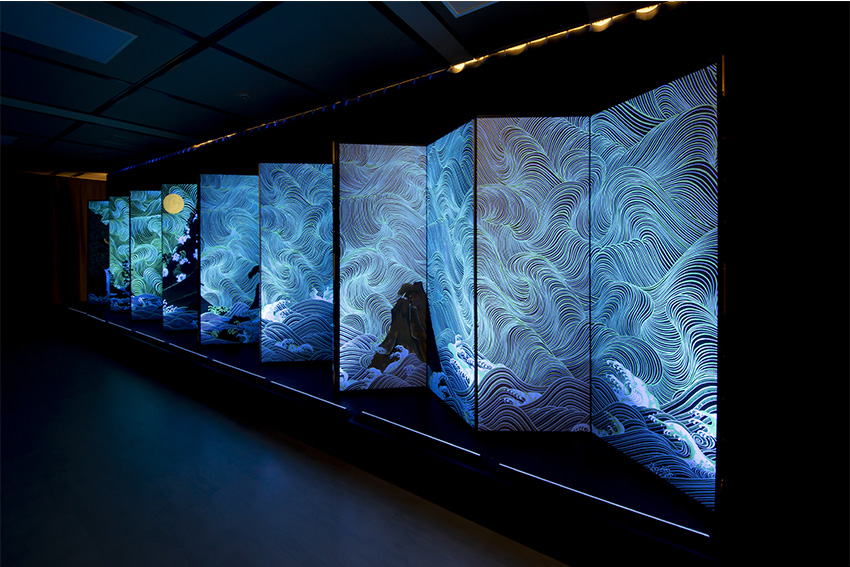With origins dating back to 1867, the TSUKAKI Group has expanded from the traditional industries of dyeing and weaving, and continues to grow through Hawaii weddings and New York real estate.

By Paul Mannion and Sean McBride
The TSUKAKI Group was initially established as a kimono wholesaler in Kyoto in 1867, by the current president’s great-grandfather and namesake Kizaemon Tsukamoto, who hailed from Gokasho Kondo Town, a preserved townscape in the birthplace of the Omi merchants.
Taking the Omi merchant philosophy sampo-yoshi, or ‘three-way satisfaction,’ as its inspiration, the company has grown steadily and is still thriving today, having successfully negotiated a series of crises (the Meiji Restoration, the Great Kanto Earthquake, the Great Depression, WWII) throughout its 150-year history.
Of the group’s seven business divisions, which encompass the traditional industries of dyeing and weaving as well as the fields of pearls, jewelry and shapewear for women, perhaps the most famous is its original company, Tsukaki Shoji Co., Ltd.
Today it is responsible for the Nishijin-ori Asagi Art Museum, which was established in 2019, and showcases the highest artistry of Nishijin-ori, a traditional weaving technique which has been a hallmark of Japanese culture and art from the Heian to the Edo period. The museum offers an immersive experience, allowing visitors to learn about and experience intricate techniques like silk, pure gold thread, foil and Jacquard loom weaving. It is also home to a remarkable Nishijin-ori collection of Ukiyo-e art, which depicts Kabuki actors, Mount Fuji and daily life in the Edo period (1603-1868). Ukiyo-e art had a profound influence on a number of European impressionists, including Vincent Van Gogh.
In July 2024, Tsukaki Shoji opened its pioneering Tango Creative Center in Tango, Japan’s largest silk weaving region, with a view to training young artisans in the craft of traditional Nishijin-ori. The center, a response to Japan’s well-documented demographic shift, which could see established traditions being lost as the older generation dies out, also serves as an open factory where visitors can observe the Nishijin-ori weaving process, while its second floor houses a museum dedicated to the practice.
Also operating along more traditional lines is Kyoto-based kimono manufacturer Kyoho, which has a dyeing workshop in Narutaki. The firm uses the Suminagashi dyeing process, a technique that originated in the ninth century when Heian-era aristocrats floated ink on water and transferred the patterns to Japanese paper. Having revived the practice, Kyoho has successfully incorporated it into Kyoto-style Yuzen kimono designs, drawing attention from around the world.
Established half a century ago within the group, Tsukaki Co., Ltd. operates as a jewelry specialist, dealing in pearls and rare colored diamonds and earning widespread recognition from global gemstone buyers. The firm, which this year celebrated its 50th anniversary, is notable for sourcing new gemstones from mines in Madagascar, specializing in demantoid garnet, grandidierite and Bekily garnet.
Tamura Co., Ltd., meanwhile, focusing on feminine beauty, holds multiple patents for women’s underwear and has recently developed a new bra technology that stretches and contracts freely based on changes in body shape. This groundbreaking product, which accommodates changes owing to breastfeeding or fluctuations in weight, allows women to feel comfortable in their own skin at all times.
Looking to the future, the TSUKAKI Group continues to grow and expand. The recent acquisition of a building in New York signals a new venture in the field of asset management, while the group also has plans to enter the Hawaiian wedding market in 2025.
With its high-quality furs and jewelry from Italy and France, its pearl and gemstone exports, its cutting-edge women’s underwear and its continued promotion of the Nishijin-ori technique to a fascinated public in the U.S. and Europe, the TSUKAKI Group, which started as a small firm, continues to grow into a special company worldwide in the 21st century.
0 COMMENTS